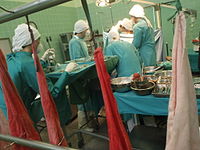
Photo from wikipedia
Lung allograft recipients have worse survival than all other solid organ transplant recipients, largely because of primary graft dysfunction (PGD), a major form of acute lung injury affecting a third… Click to show full abstract
Lung allograft recipients have worse survival than all other solid organ transplant recipients, largely because of primary graft dysfunction (PGD), a major form of acute lung injury affecting a third of lung recipients within the first 72 h after transplant. PGD is the clinical manifestation of ischemia-reperfusion injury and represents the predominate cause of early morbidity and mortality. Despite PGD's impact on lung transplant outcomes, no targeted therapies are currently available; hence, care remains supportive and largely ineffective. This review focuses on molecular and innate immune mechanisms of ischemia-reperfusion injury leading to PGD. We also discuss novel research aimed at discovering biomarkers that could better predict PGD and potential targeted interventions that may improve outcomes in lung transplantation.
Journal Title: Transplantation
Year Published: 2023
Link to full text (if available)
Share on Social Media: Sign Up to like & get
recommendations!